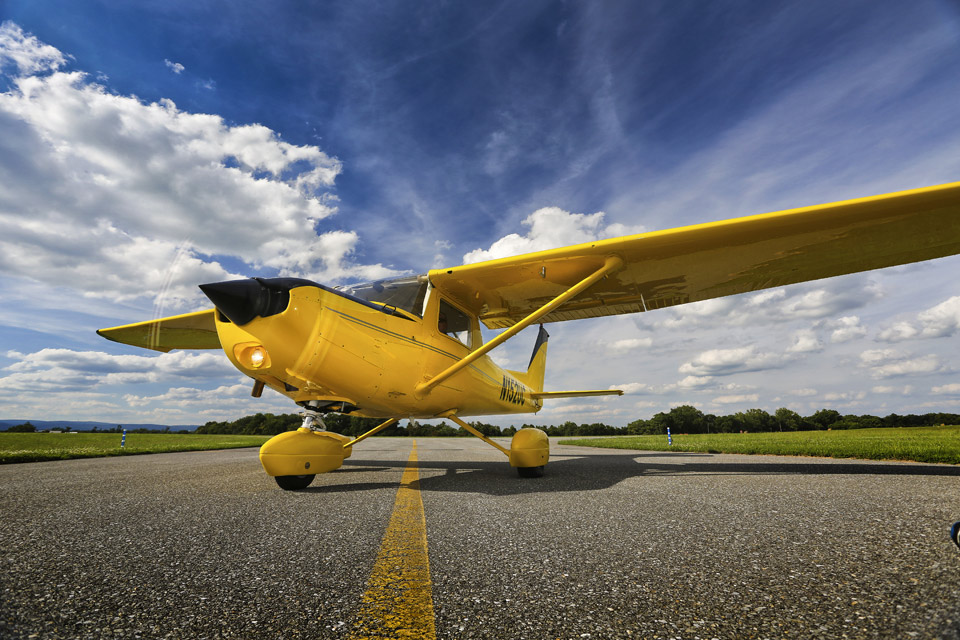Sweepstakes 2015: GA Aircraft Reimagined
Filling a void in the marketplace
Among the many exotic aircraft at the world’s largest airshow, a once-common Cessna 152 trainer at the AOPA tent at AirVenture drew more than its share of curiosity.
What’s so special about this airplane? Who restored it to as-new condition? And is it going to be given away in the 2015 AOPA Sweepstakes?
The answers seemed to capture the imaginations of pilots, aircraft owners, and others at EAA AirVenture 2014 interested in seeing general aviation thrive again.
This “Reimagined” Cessna 152 is the first in an AOPA test to find out whether refurbished aircraft can provide a notable value to flying clubs and flight schools. If the answer is yes, perhaps these tough, proven airplanes that already have trained two generations of GA pilots can be updated and continue providing affordable access to aviation for many more pilots in the years to come. And yes, one of the much-talked-about yellow 152s rebuilt for AOPA by the craftsmen at Aviat Aircraft in Afton, Wyoming, will be the 2015 AOPA Sweepstakes prize.
AOPA also will put other Aviat-restored 150s and 152s to work around the country visiting flying clubs, appearing at aviation events, creating new pilots, and keeping existing ones in the air.

By negotiating in advance with banks and insurance underwriters, AOPA is opening the doors for flying clubs, flight schools, and partnerships to be able to affordably insure and finance a reimagined aircraft.
The base price for a newly refurbished Cessna 152 from Aviat, for example, is $99,900. And while that may seem astronomical compared to Cessna’s retail price of $40,900 in 1985, the last year the Kansas company manufactured them, it’s close in inflation-adjusted dollars—and significantly less than many newly manufactured aircraft, and a fraction of new FAA-certified trainers.
AOPA President Mark Baker learned to fly in a Cessna 150 when he was a student at the University of Minnesota.
The ailerons are crisp and taut, and slightly heavier than the elevator and rudder. The seating position feels odd with my feet so close together and left calf resting against the bulkhead. All of these observations seem like rediscovering something I should have remembered. But when I learned to fly decades ago in a similar airplane, I had no frame of reference. The open vents provide plenty of air flow, even on a humid summer afternoon.
The colorful moving-map GPS showing FIS-B weather is a quantum leap from the single, cantankerous, vacuum-tube VOR I remember, and the Garmin GTR 225 radio provides audio clarity I wouldn’t have thought possible back then.
In the landing pattern, there’s a slight nose-up moment when the electric flaps fully deploy to 30 degrees, a smidge of power holds the VASI glideslope at 60 KIAS, and the airplane touches down without any drama on the mains. On the next circuit, I try one of my former instructor’s favorite forms of precision punishment: holding exactly 60 knots on climb-out, crosswind, downwind, and final. The obedient airplane makes this once-taxing exercise a breeze.
I feel like a hand in a glove by the time I taxi back to the ramp and shut down, even though the entire flight added just 0.5 hours to the tally on the Hobbs meter. This little airplane packs a lot of action, and enjoyment, in only five gallons of avgas per hour.
It’s not going to be easy for a 35-year-old design like the Cessna 152 to compete against newer aircraft made from modern materials with glass-panel avionics, but don’t count them out. This first batch of tough, proven, and resilient trainers to emerge from the Aviat factory will have a conspicuous presence at aviation events around the country, and they’re likely to be followed by many more. And when pilots of my generation see these beautifully restored trainers, they’ll feel an immediate attachment to them, they’ll want to fly them, and they’ll want their sons and daughters to do the same.
Email [email protected]
SPEC SHEET
Cessna 152
Base price in 1985 | $40,900 (refurbished today $99,900)
Top speed | 109 kts
Rate of climb | 715 fpm
Max range | 370 nm
Service ceiling | 14,700 ft
Gross weight | 1,670 ft
Useful load | 566 lb
Total number of Cessna 150s manufactured | 23,948
Total number of Cessna 152s manufactured | 7,585
Memories rush back to pilots who learned in Cessna 150s or 152s, and flying one after a long absence likely will remind you of the formative flying experiences you haven’t thought of in a very long time—send us your recollections. The airplane’s flying characteristics are as forgiving, revealing, and enjoyable as ever. With some skillful attention, these still-plentiful airframes can be restored and help shape another generation of pilots.

Video Extra: Fly along with us in the Reimagined 152 in this AOPA Live This Week video.